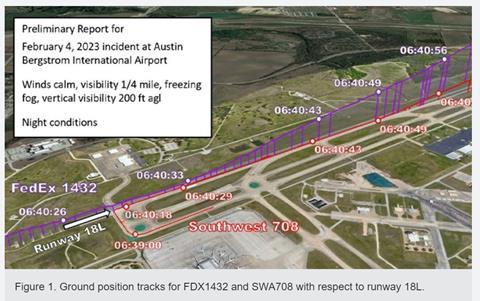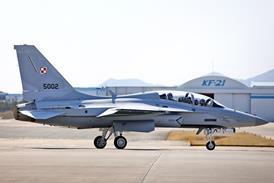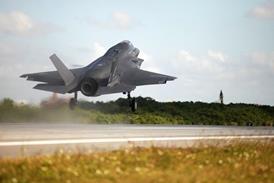US investigators have pinned a near-miss at Austin-Bergstrom International airport in February last year, in which two jets came within as little as 150ft of colliding, on incorrect assumptions made by a controller and “the lack of critical safety technology” at the facility.
The 4 February 2023 incident saw a FedEx 767-300 Freighter overfly a Southwest Airlines Boeing 737-700 after it was forced to execute a go-around when the narrowbody was cleared to depart from a runway on which it was landing in foggy conditions early in the morning.
As a result, the National Transportation Safety Board (NTSB) has urged the Federal Aviation Administration (FAA) to install ground-surveillance technology at all major airports in the USA dealing handling large commercial aircraft.
It is among more than 10 near-misses at US airports in recent years. The events represent a troubling trend and have prompted regulators and safety experts to seek answers.
During a 6 June hearing in Washington DC, the NTSB agreed that an air traffic controller’s failure to know the position of the Southwest jet – which was taxiing at the time – directly caused the Austin incident.
But the board cited numerous contributing factors, including a lack of surface-detection equipment at Austin to accurately track aircraft on the ground.

Visibility at the airport as the incident unfolded at around 06:40 local was only 0.25 miles (0.40km) due to dense fog, which kept the controller from seeing the Southwest aircraft (N7827A) as it taxied toward the runway for take-off, the NTSB says. At the same time, the FedEx jet (N297FE) was on final approach.
The NTSB notes that the Southwest pilots requested take-off clearance when they were still 168m (550ft) from the runway threshold. The controller granted the request under the incorrect assumption that the 737 was already at the threshold and ready to go – a condition the NTSB calls “expectation bias”.
As a result, the controller experienced an “inaccurate mental model” of the 737’s location and a “lack of situational awareness”, and also failed to verify the jet’s position with its pilots, the board says.
Compounding the issue, the Southwest pilots, after reaching the runway threshold, did not immediately begin the take-off roll. Instead, without notifying the controller, they stopped the aircraft for 19s to run up its engines, as required when using the anti-ice system.
By that time, the FedEx 767 was 33s from crossing the runway threshold.
The NTSB says the Southwest pilots should have informed the controller that they intended to complete the engine run-up prior to departure.
As the Southwest 737 began its take-off roll, separation between the two aircraft “continued to decrease until the FedEx flightcrew saw the outline of the Southwest [jet] through the fog and called for the performed go-around,” says Michael Hoff, the NTSB investigator leading the inquiry.
Analysis showed that at their closest point, the two aircraft were as little as 150-170ft apart.
“This incident could have been catastrophic if not for the heroic actions of the FedEx crew,” says NTSB chair Jennifer Homendy. “I do believe that the excellent communications between [the pilots] really saved the lives of 138 people.”
The FedEx jet circled before landing safely at Austin, while the Southwest aircraft departed, completing its flight to Cancun without further incident.
The NTSB insists the near-miss would have been avoided if Austin had surface-surveillance technology, showing controllers the location of aircraft on the ground.
Although the NTSB first recommended airports install such systems in 1991, little progress appears to have been made. In its response to the incident, the safety body has again urged the FAA to install ground-surveillance technology at all US airports that accommodate large commercial aircraft.
It also recommends more training for controllers and that pilots notify controllers when needing extra time on the runway before take-off.
The FAA did not immediately respond to a request for comment but has been installing surface-surveillance technology at more US airports, including Austin, which is supposed to receive a system by July.
The NTSB is investigating over 10 recent close calls at US airports, including a January 2023 event at New York’s John F Kennedy International airport and a more recent runway mishap at Ronald Reagan Washington National airport.
On 4 June, the NTSB said surface-surveillance technology prevented the JFK incident from being a disaster. That event involved the pilots of an American Airlines 777 mistakenly taxiing – due to being distracted – across a runway on which a Delta Air Lines 737 was departing. Controllers ordered the 737’s pilots to abort their take-off after receiving a warning from a ground-surveillance system.
The FAA has reported 23 serious runway incursions in 2023 – up from 16 in 2022 – and seven this year. “We are trending in the wrong direction,” says Homendy.


























